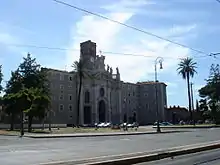Antonietta Meo
Antonietta Meo (December 15, 1930 – July 3, 1937)[1] was an Italian girl who may become the youngest person on the way to Sainthood who is a confessor (not a martyr) ever canonized by the Roman Catholic Church.
Antonietta Meo | |
|---|---|
 Portrait of Antonietta Meo, circa 1937. | |
| Confessor, Laywoman | |
| Born | December 15, 1930 Rome, Italy |
| Died | July 3, 1937 (aged 6) Rome, Italy |
| Venerated in | Catholic Church |
| Major shrine | Santa Croce Basilica, Gerusalemme, Rome, Italy |
| Feast | July 3 |
Life and death
Antonietta was raised in an upper middle class household in Rome as the younger daughter of Michele and Maria Meo. She was nicknamed "Nennolina." She attended Catholic schools and stood out as an active, charismatic little girl who led her playmates in all their games, even after she became ill, and was popular with them because of her kindness. Her teachers said she was a child like other children, but stood out because of her personal charm and her sense of humor and the joyousness of her personality.[1]
She was diagnosed with osteosarcoma, an aggressive form of bone cancer, at the age of five after she fell and injured her knee and the injury didn't heal. When her leg had to be amputated, she bore the ordeal "cheerfully." She was fitted with a heavy, artificial leg so she could keep playing with other youngsters. Catholic theologians have called her a "mystic" because the six-year-old wrote "extraordinary" letters to Jesus Christ in the last months of her life that displayed understanding and actions beyond the normal for a child of her age. "Dear baby Jesus, you are holy, you are good," she wrote in one of the letters. "Help me, grant me your grace and give me back my leg. If you don't want to, then may your will be done."
At first she dictated letters to her mother; later she wrote poems and letters herself and left each at the foot of her crucifix. In another letter she wrote: "Dear Jesus, I love you very much. I want to abandon myself in your hands. I want to abandon myself in your arms. Do with me what you want. Help me with your grace. You help me, since without your grace, I am nothing."[2] She wrote or dictated more than 100 letters to Jesus or to the Virgin Mary, describing "holy visions" in many of them.[3] After Mass, people sometimes saw her approach the tabernacle and say, "Jesus, come and play with me!"[4]

The child viewed the loss of her leg as a sacrifice to Jesus for the conversion of sinners. "I am very happy that Jesus gave me this problem so that I may be his dearest one," she told her father, Michele, after her leg was amputated.[4] "Pain is like fabric, the stronger it is, the more it's worth," she told her father. She told her spiritual guide: "For an instant I lie down on my wound, so as to offer more pain to Jesus," and told her mother: "When you feel pain, you have to keep quiet and offer it to Jesus for a sinner. Jesus suffered so much for us, but He hadn't committed any sin: He was God. How could we complain, we who are sinners and always offend him?" She was eager to receive the sacraments of the Catholic Church and was baptized, made her first confession, was confirmed and made her first communion before her death. She also received extreme unction, the last rites, in June 1937.[5]
She insisted on writing a last letter to Jesus a few days before her death, even though it was interrupted when she had to vomit. In it, she asked Jesus to take care of everyone she loved, and asked for strength to bear her pain. She finished the letter with the words "Your little girl sends you a lot of kisses." She told her mother when it was time for her to die. "In a few hours, I will die, but I will not suffer anymore, and you shouldn't cry. I should have lived a few days longer, but Saint Theresa of the Child Jesus said, "it's enough!"[6] After the child's death, her mother had a vision of Antonietta in a glorified state that reassured her that the child was now in heaven.
Canonization efforts

Efforts to make her a saint began soon after her death. Her case was referred to the Congregation for the Promulgation of Saints in May 1972.[7] Pope Benedict XVI approved a decree on December 17, 2007, seventy years after her death, praising the girl's "heroic virtues" and giving approval for the process to begin to declare her a saint. Once the Pope recognizes a candidate's "heroic virtues", they are called a "Venerable Servant of God." [8][9] The process requires two approved miracles to first beatify her and then canonize her as a saint. One miracle has already been attributed to Antonietta. A woman in Indiana claimed that she was healed of Hepatitis C after praying to Antonietta.[7]
A shrine with relics of her life is in the Basilica Santa Croce, in Gerusalemme in Rome, the church where she was baptized and spent much of her time in meditation. Antonietta's body was moved inside the church in 1999.[7]
Other young saints
Other young people have been canonized as saints. The Catholic Church commemorates as the first Christian martyrs the Holy Innocents, a group of male children two years old and younger whom the Gospel of Matthew describes as having been murdered in Jesus' stead by order of King Herod the Great. The youngest saints canonized by the Roman Catholic Church in modern times are Francisco and Jacinta Marto, two Portuguese child witnesses of the 1917 Marian apparitions at Fatima, who died at ages 10 and 9 respectively in 1919 and 1920, victims of the 1918 influenza pandemic. Upon their 2017 canonization, the Marto children became the two youngest non-martyred Catholic saints in history.[10] The next-youngest modern saint, Maria Goretti, died in 1902 at age eleven and was canonized in 1950 as "virgin and martyr."
Before 1981, the Vatican Congregation for Saints previously required that a candidate for sainthood reach some level of maturity. In 1981, it relaxed that rule, declaring that "It is possible to speak of a human being being precocious in their sense of good and evil."[11]
Notes
- "Nennolina.it". Archived from the original on 22 March 2016. Retrieved 6 October 2016.
- Alive! (2008). "Child cancer victim could become youngest saint". "Alive!". Archived from the original on 2 March 2008. Retrieved February 19, 2008.
- Angela E. Pometto (2006). "Walking off the map and into the Holy Land". "Catholic Herald". Retrieved February 20, 2008.
- Deacon John Giglio Jr. "MARY, OUR MOTHER". deaconjohn1987.blogspot.com. Retrieved 18 September 2015.
- "Nennolina.it". Archived from the original on 3 March 2016. Retrieved 6 October 2016.
- Deacon John Giglio Jr. "MARY, OUR MOTHER: Children of Medjugorje February Newsletter". deaconjohn1987.blogspot.com. Retrieved 18 September 2015.
- Azionecattolica.it Archived February 29, 2008, at the Wayback Machine
- Venerable Antonietta Meo Archived December 9, 2014, at the Wayback Machine. PONTIFICIUM OPUS A SANCTA INFANTIA - Holy See
- "The Process of Beatification and Canonization". ewtn.com. Retrieved 18 September 2015.
- "Pope canonizes children behind 'Three Secrets of Fatima'".
- Catholic News Agency (2007). "Italian six-year-old takes next step towards sainthood". "Catholic News Agency". Retrieved February 19, 2008.
External links
- "Antonietta Meo". Find a Grave. Retrieved September 2, 2010.